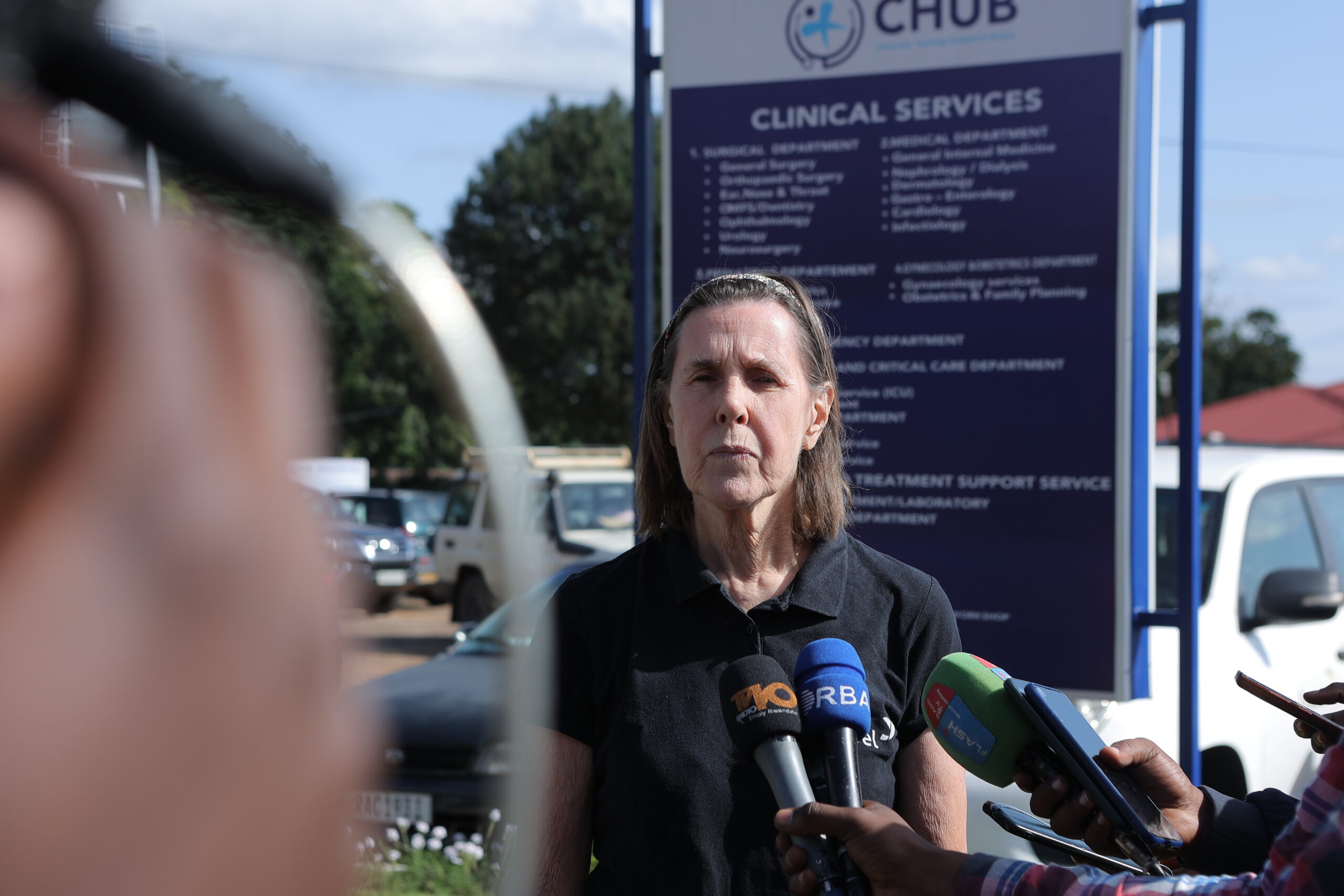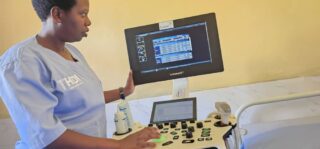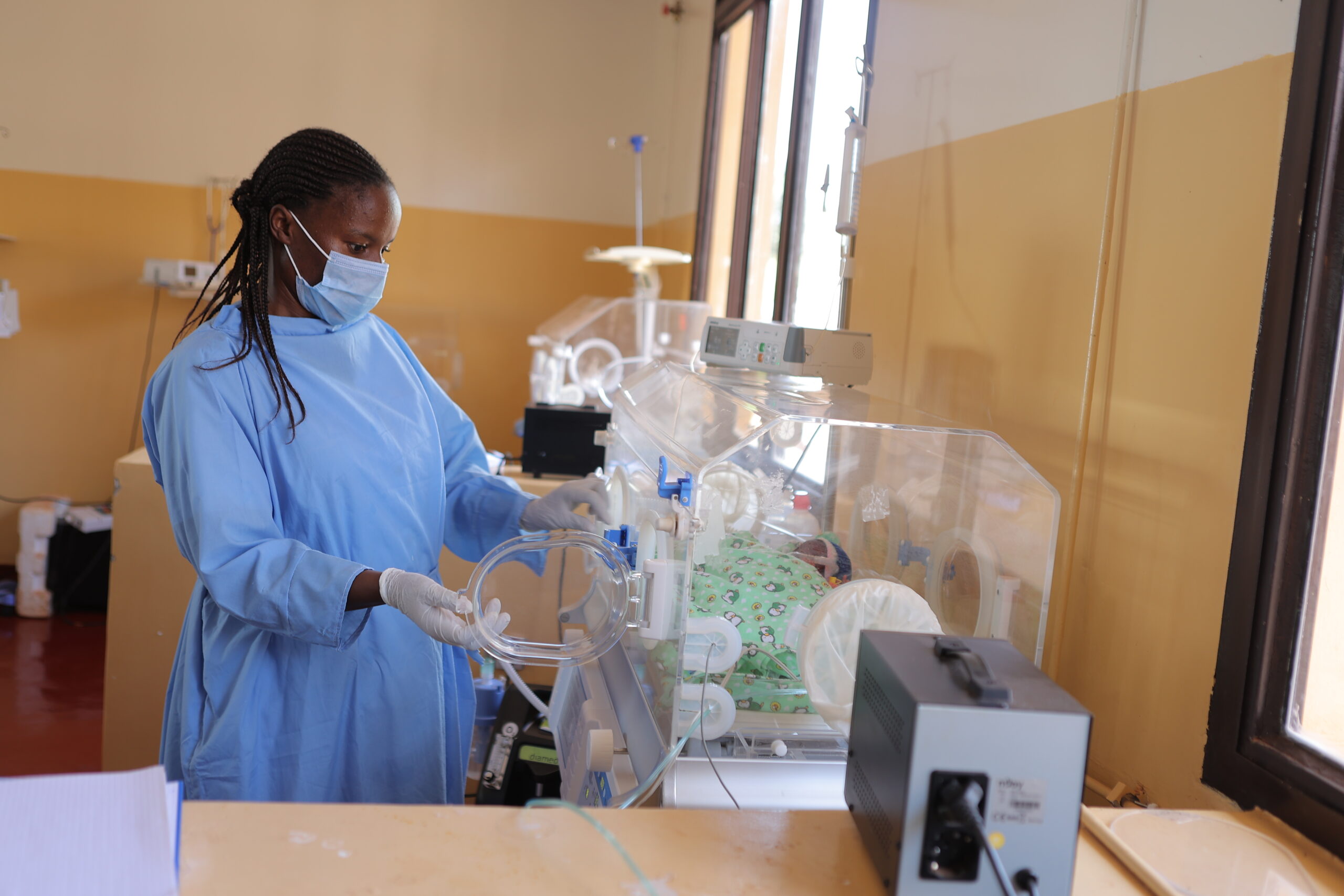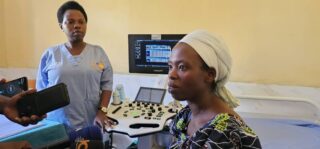
Dr. Mary Hadley, the Enabel Monitoring and Evaluation Technical Advisor speaking to media about the CPAP research results.
Using high-end maternity care equipment donated under the Belgian- Rwanda health cooperation has proven to be one of the ways that will enable Rwanda to meet its targets of reducing neonatal mortalities.
Though Rwanda has in the last 15 years made great strides in reducing child mortality to cut its under-5 mortality rate by a remarkable 79% since 2000, the RwandaDemographic Health Survey (2019/20) indicates that neonatal mortality is not reducing at the same rate as child mortality.
For example,neonatal deaths (under a month) stood at 20/1000 children in 2014/15 and reduced to 19/1000 in 2019/20 and the under five-years child mortality reduced from 196/1000 (in 2019/20) to 50/1000 and 45/1000 in the fiscal year 2014/15-2019/20 respectively.
At theUniversity Teaching Hospital in Butare (CHUB), health researchers say that using the Continuous positive airway pressure (CPAP) machines in maternal healthcare is playing a significant role in further reducing neonatal mortality rates in the hospital that serves residents of Huye and part of its neighboring district- Nyamagabe.
CPAP is a respiratory therapy methodology that is used to enable a newborn child who is born with breathing complications (disorders), to breath well and during the therapy, air is pumped into the lungs through the nose or nose and mouth.
 There are two types of CPAP methods that can be used in a hospital setting- the factory-madeor the fabricated (improvised) one- with the former being more effective in enabling a child to breathe.
There are two types of CPAP methods that can be used in a hospital setting- the factory-madeor the fabricated (improvised) one- with the former being more effective in enabling a child to breathe.
As of 2022,the CHUB referral hospital had one of the highest neonatal’s deaths in Rwanda(64% against the national figure of 52%) and according to officials, this was because the worst pregnancy cases were referred from district hospitals-which had no CPAP machines at the time.
However, when the hospital received 10 factory-made CPAPs (out of the 74 donated by Enabel-a Belgian Development Agency; and other sources), the neonatal care witnessed a reduction in newborn deaths- a realization that compelled a CPAP research to find out if the machines were the reason behind.
At CHUB Neonatal Intensive Care Unit (NICU) admits between 50 and 80 neonates each month. Of these over 37% are premature. The mortality rate of those admitted to the ward before the CPAPs was at 24% children (mainly caused by breathing issues).
However, the use of CPAPs has seen the numbers of neonatal deaths reduced below 8%.
The research shows that out of the 80 neonates admitted, the factory-made CPAPs enabled 59 children to survive, while the improvised CPAPs managed to save 21 babies.
“We did this study using international standards of research and we came to the conclusion that absolutely those CPAP machines given to the hospital were the ones making a difference to the neonatal mortality,” said Dr. Mary Hadley, the Enabel Monitoring and Evaluation Technical Advisor- Maternal, Neonatal, Child, Sexual and Reproductive Health.
The evidence-based research results have helped the CHUB hospital but much more than that they have been presented at different health forums, to district hospital directors, Ministry of Health, and expected to inform the 5th Rwanda Health Sector Strategic plan (which is underway)- 2024-2029.
Dr. Hadley said that this research goes beyond Rwanda and can be used in other regional countries to benefit mothers and new born but following the data and listening to the beneficiaries’ feedback all the time-to enable one to understand the dynamics of maternal healthcare.
This is one of the 25 ongoing researches that the CHUB research unit operates without extra funding from Enabel except for technical assistance in conducting research and data analysis.
“We do the research to try to improve the health outcomes of babies and mothers when they leave this hospital but also to work with local researchers, and support the doctors and nurses to do their research because they know what is wrong or what the problem is,” Hadley said.
At Kibirizi Hospital in Gisagara district they had two CPAP machines but with donations from Enabel they have increased to seven, and this has enabled to increase newborn survival chances but also contribute to other comprehensive maternal health interventions.
Yvette Umukundwa, the Director of Nursing and Midwifery at Kibirizi Hospital says that the CPAP machines have reduced neonatal deaths from 15% (in 2021) to 9.4% to date as a result of equipping the hospital and training staff.
However, Umukundwa says that as the number of patients increases they will need more machines to save high risk premature newborn cases.

Lydia Muhoza, a trained midwife using an ultrasound machine at Rubengera Health Center
At Rubengera Health Center, is an ultrasound machine that has improved ways of reducing risks a mother and unborn babies can face if not detected beforehand- at conception and during the pregnancy.
Ultrasound machines, which scan the fetus and the expectant mother’s conditions are normally found in hospitals but through the Belgian-Rwanda health cooperation 105 machines were donated to health centres across the country and midwives trained to use them.
At the centre, Lydia Muhoza, a trained Midwife says that most midwives are not taught how to use ultrasound machines and this is considered to be an equipment for doctors only, however through the cooperation activities, she was trained (for two weeks) and now able to use the machine.
One of her patients is Florence Mutuyimana, who has just gone through an ultrasound examination and didn’t know she was pregnant until she went through the test.
“I have 11 months of twins and didn’t know that I had a 30 weeks pregnancy until now when the medic told me that I had conceived again. Now, I know how old the pregnancy is, when I will give birth safely,” Mutuyimana said.

Neonatal intensive care equipment in Kibilizi hospital
Previously, Muhoza says this detection was hard as they only used to the Stethoscope and bare palms to test pregnant mothers especially the position and breathing of the fetus- which was 80% inaccurate and hard to detect whether a woman is pregnant or not thus most cases were referred to hospital- thus making long distances to acquire the service.
“With the availability of an ultrasound machine, midwives can see if the baby and the placenta are in the right position and if any complications in one of these is detected, then the mother is referred to get medical attention,” Muhoza said.
Using ultrasounds (currently done free of charge) has improved the midwives’ health services and number of mothers seeking the service, reduced risks of mothers and babies getting complications during a pregnancy.
For instance, Muhoza handles an average of 21 patients a day and 180 cases per month.

Florence Mutuyimana, (R) a mother of twins after having a free ultrasound test found she was pregnant for weeks
The mothers seeking ultra sound services increased from an average of 70-90 to between 100-150 per month.
Detected risks of giving birth with complications that were captured on time in the last six months increased from 241 were referred to hospitals and this also increased the number of births in health facilities from 87% to 96% to date.
Even when sustainability is granted by training midwives and biomedical technicians to maintain the machines, Muhoza says that the midwifery curriculum should consider this course.
Dr. Francois Regis Cyiza, Director of Health Facilities Programs Unit-Maternal Child and community Health Division at RBC says that in the next five-year Belgium- Rwanda health cooperation the biggest budget focus will be put in health equipment, training and improved infrastructure and spaces of operation.

